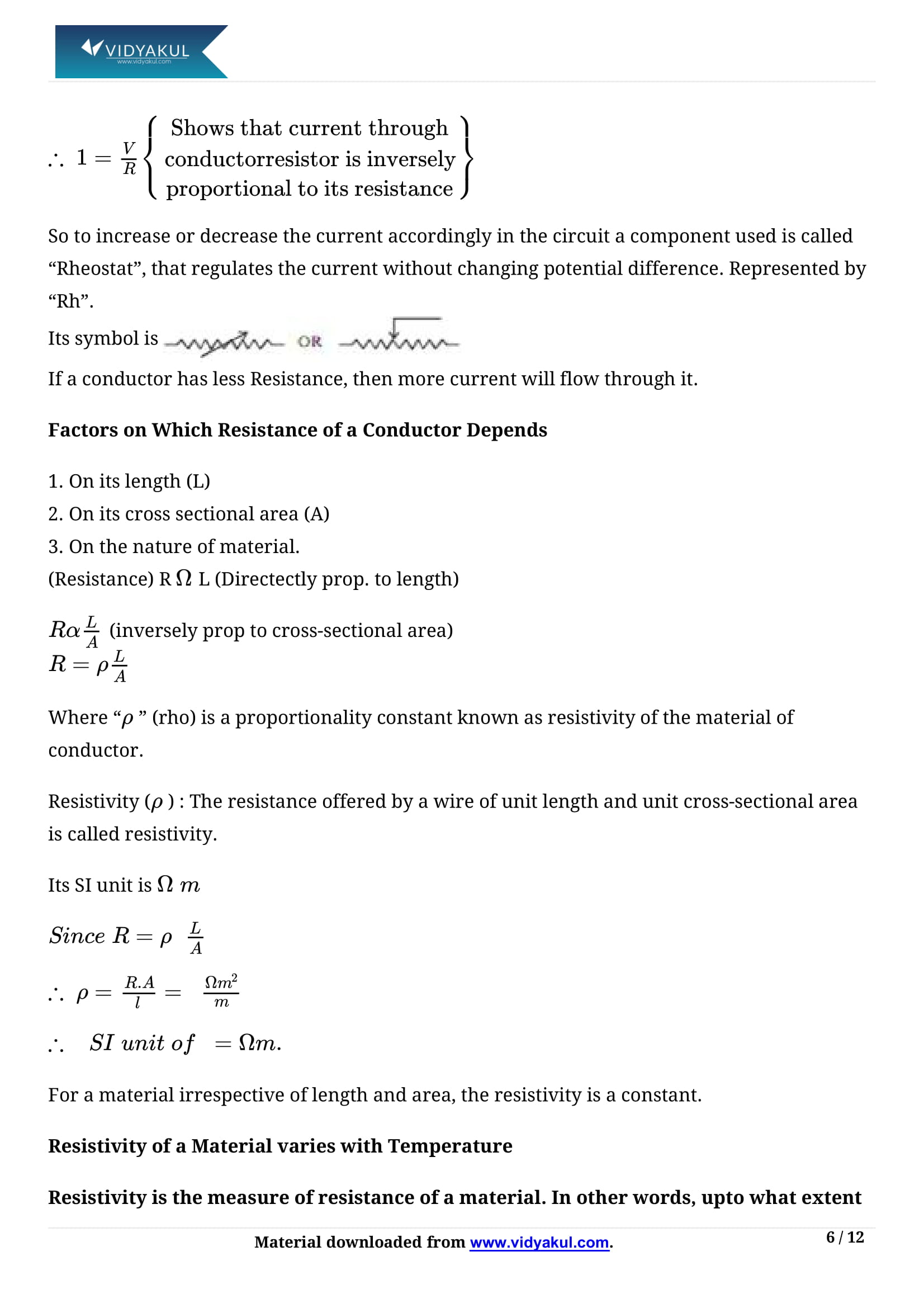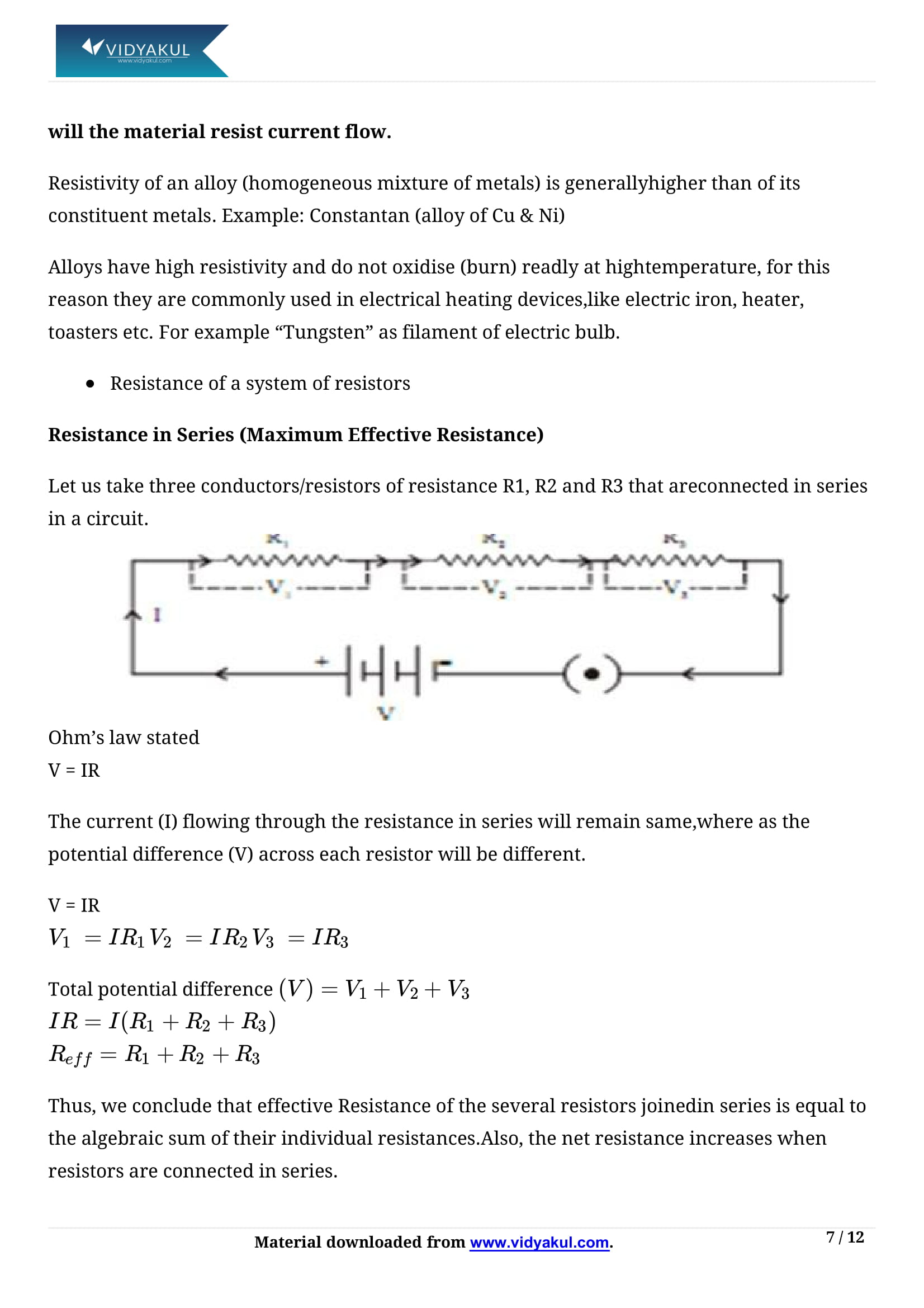Electricity Class 10 Notes

Chapter 12 Electricity
CBSE Chapter 12 Science Lesson 10 is about electricity. Students taking the test should ensure that they are correctly following the NCERT notes for 10th Grade Science Chapter 12 Electrical in order to achieve higher test scores. However, it will help you do well on your final exam and lay a solid foundation for your competitive exams.
Vidyakul provides a set of over 450 exercises covering all subtopics in Chapter 12. Students should pay special attention to working through all text questions provided by Vidyakul. Read on to access NCERT notes for Class 10, Chapter 12, Electrical.
CBSE CLASS 10th SCIENCE CH-12
Points to Remember
Below mentioned are some of the important points to be remembered from NCERT Class 10 Science Chapter 12 to score good marks in the exams:
Current
(i) Current through a given area of a conductor is the net charge passing per unit time through the area.
(ii) SI unit of current is ampere and it is a scalar quantity.
Electromotive force:
The work done per unit charge by the source in taking the charge from lower to higher potential energy is called the source’s electromotive force, or emf.
Ohm’s law:
(i) Ohm’s law: The electric current I flowing through a substance is proportional to the voltage V across its ends, i.e., V∝I or V=RI, where R is called the resistance of the substance. The SI unit of resistance is ohm(Ω).
Temperature coefficient of resistivity:
In the temperature range in which resistivity increases linearly with temperature, the temperature coefficient of resistivity is defined as the fractional increase in resistivity per unit increase in temperature.
Kirchhoff’s law:
(i) Kirchhoff’s junction Rule: At any junction of circuit elements, the sum of currents entering the junction must be equal the sum of currents leaving it.
(ii) Kirchhoff’s Loop Rule: The algebraic sum of changes in potential around any closed loop must be zero.
Potentiometer:
(i) A potentiometer is a linear conductor of uniform cross-section with a steady current set up in it. This maintains a uniform potential gradient along the length of the wire. Any potential difference which is less than the potential difference maintained across the potentiometer wire can be measured.
Topics and Sub- topics
Students may initially find electrical problems in Chapter 12 of NCERT Grade 10 Science. If students try to understand the concepts by following the video, they will be able to solve the problems easily. Students should try to solve a lot of questions in order to effectively cover all types of questions on the exam.
Vidyakul provides free notes to all Year 10 Science Chapter 12 problems for students. Concepts and problems are based on the latest programs. In addition to the free NCERT notes, Vidyakul provides free NCERT 3D videos, NCERT examples, and more.
Students can find the list of topics included in Class 10 Science chapter 12 as mentioned below:
Few Important Questions
What is an electric circuit?
Electric circuit is a path for transmitting electric current. It is used in lamps, motors, computers and many other electronic devices.
What does the ‘Ohm’s Law’ state?
Ohm’s Law states that the current through a conductor is proportional to the voltage across the conductor.
What is electric power?
The rate, per unit time, at which electrical energy is transferred by an eletric current is known as electric power.
Current
(i) Current through a given area of a conductor is the net charge passing per unit time through the area.
(ii) SI unit of current is ampere and it is a scalar quantity.
Electromotive force:
The work done per unit charge by the source in taking the charge from lower to higher potential energy is called the source’s electromotive force, or emf.
Ohm’s law:
(i) Ohm’s law: The electric current I flowing through a substance is proportional to the voltage V across its ends, i.e., V∝I or V=RI, where R is called the resistance of the substance. The SI unit of resistance is ohm(Ω).
Temperature coefficient of resistivity:
In the temperature range in which resistivity increases linearly with temperature, the temperature coefficient of resistivity is defined as the fractional increase in resistivity per unit increase in temperature.
Kirchhoff’s law:
(i) Kirchhoff’s junction Rule: At any junction of circuit elements, the sum of currents entering the junction must be equal the sum of currents leaving it.
(ii) Kirchhoff’s Loop Rule: The algebraic sum of changes in potential around any closed loop must be zero.
Potentiometer:
(i) A potentiometer is a linear conductor of uniform cross-section with a steady current set up in it. This maintains a uniform potential gradient along the length of the wire. Any potential difference which is less than the potential difference maintained across the potentiometer wire can be measured.
What is an electric circuit?
What does the ‘Ohm’s Law’ state?
What is electric power?
Know more about the same in Electricity Class 10 Notes pdf.
Download Latest Class 10 Sample Papers 2019 for Board Exams
- CBSE Class 10 Sample Papers 2019 PDF
- CBSE Class 10 Maths Sample Papers 2019 PDF
- CBSE Class 10 Science Sample Papers 2019 PDF
- CBSE Class 10 English Sample Papers 2019 PDF
- CBSE Class 10 Hindi Sample Paper 2019 PDF
- CBSE Class 10 Social Studies Sample Papers 2019 PDF
Download this solution for FREE Download this PDF
Download Vidyakul App for more Important videos, PDF's and Free video lectures.















